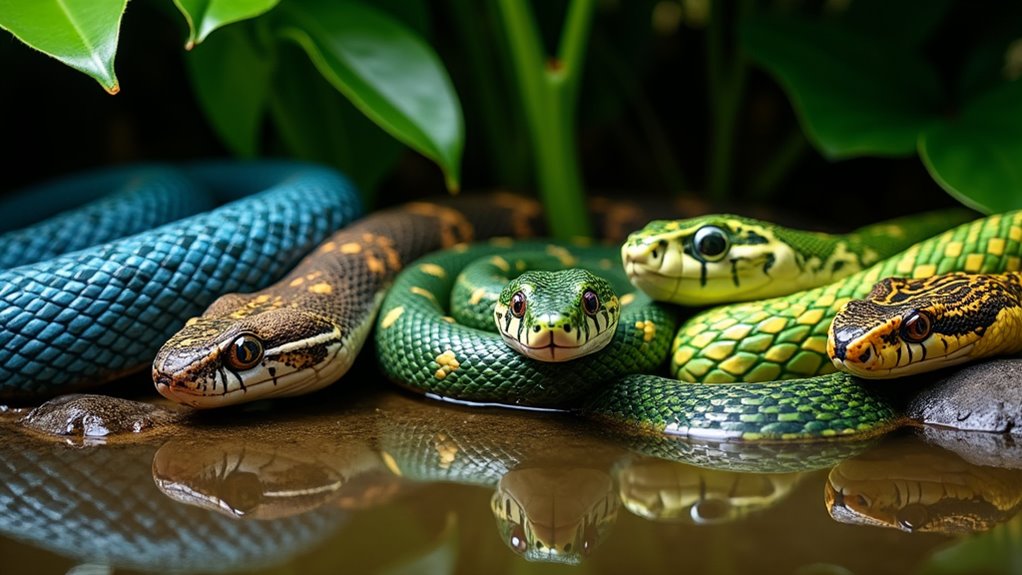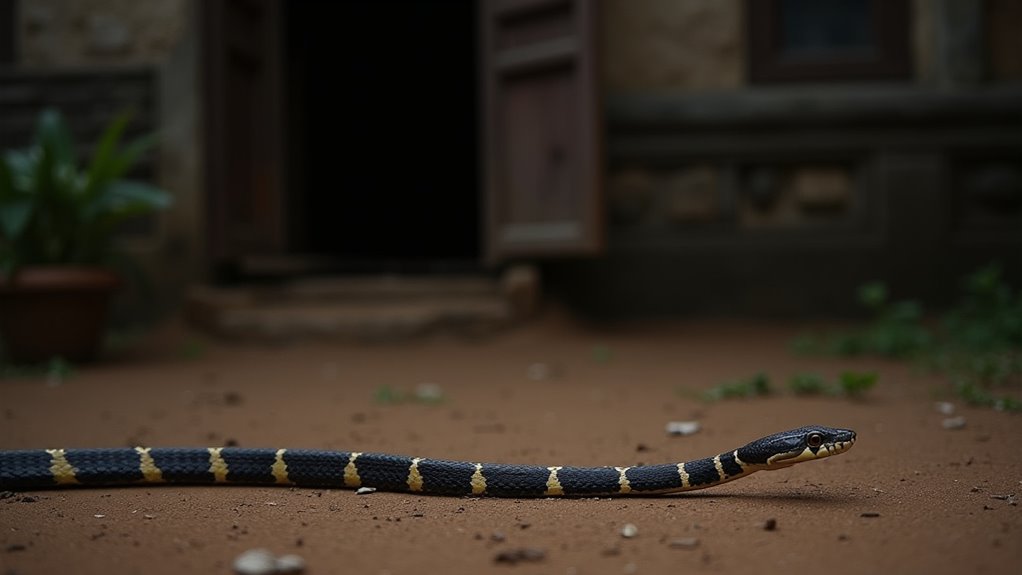Physical Address
304 North Cardinal St.
Dorchester Center, MA 02124
Physical Address
304 North Cardinal St.
Dorchester Center, MA 02124

Key venomous snakes in Bali pose real threats to paradise visitors—what crucial facts could save your life?
Is paradise complete without a dash of danger? While you’re enjoying Bali’s pristine beaches and lush jungles, several venomous serpents quietly share this island paradise with you. From the deadly blue krait to the aggressive Javan spitting cobra, these slithering residents demand your respect and awareness. Don’t let fear ruin your vacation, but understanding what lurks in those beautiful landscapes might just save your life when you least expect to need this knowledge.

Among Bali’s diverse snake species, the Blue Krait distinguishes itself as the island’s deadliest serpent. You’ll recognize this 1-1.5 meter snake by its distinctive alternating black and bluish-gray bands and sleek body.
Don’t be fooled by its shy, non-aggressive nature. The Blue Krait’s venom contains powerful neurotoxins that can cause fatal respiratory paralysis. With an untreated bite having a 60-70% mortality rate, this snake deserves serious caution.
Despite its timid demeanor, the Blue Krait delivers one of nature’s deadliest toxins—capable of silently shutting down your ability to breathe.
What makes it particularly dangerous is the delayed onset of symptoms, often appearing hours after a bite occurs. The Blue Krait is considered one of the most dangerous animals in Indonesia, not just among snakes.
If you’re exploring Bali, especially in rural areas or near water sources at night, wear closed shoes and use a flashlight.
Should you encounter this snake, keep your distance. If bitten, immobilize the limb and seek immediate medical attention—rapid antivenom administration within 4-6 hours is critical for survival.
While you’re exploring Bali’s diverse snake species, you’ll likely hear about the Javan spitting cobra, a truly remarkable reptile with a unique defensive strategy. This medium-sized brown snake can be found throughout the island, even in urban areas.
What makes this cobra distinctive is its ability to spray venom up to 2 meters away when threatened. Before attacking, it’ll extend its hood as a warning sign.
Though active mainly during daylight hours, it can remain active after sunset. The Javan spitting cobra is primarily nocturnal and terrestrial, preferring to hunt small mammals and other prey at night.
If you encounter one, keep your distance. The venom can cause severe pain and swelling, and often targets the eyes of pets and people. Like many of Indonesia’s deadly animals, the Javan spitting cobra requires respect and caution when encountered in the wild. Should venom enter your eyes, rinse immediately with water and seek medical attention—anti-venom is available at some Bali hospitals.

Hidden in Bali’s rural darkness, the Malayan krait poses one of the island’s deadliest snake threats. These 1-1.5 meter serpents prefer moist forests and plantations, making rural areas their prime territory.
You’ll recognize them by their slender heads, smooth glossy scales, and triangular cross-section. Their distinctive dark bluish-black crossbands with yellowish-white interspaces make them identifiable to cautious observers. They’re solitary and exclusively nocturnal, meaning your nighttime walks carry the greatest risk of encounter.
What makes these kraits particularly dangerous is their highly neurotoxic venom. A single bite typically delivers 5mg of venom—five times the lethal dose for an adult.
Without treatment, mortality rates reach a staggering 60-70% as victims experience progressive paralysis leading to respiratory failure. If bitten, immediately seek help in tsunami safety zones where medical facilities are typically available.
If you’re staying in rural Bali, be especially cautious at night and check your shoes and bedding regularly.
Unlike Bali’s terrestrial snakes, the yellow-bellied sea snake presents a unique oceanic threat with its striking dark upper body and bright yellow underside. This pelagic creature inhabits Bali’s tropical waters, using its paddle-shaped tail and laterally compressed body to swim efficiently and maintain buoyancy at the surface. The snake can survive lengthy periods without freshwater by uptaking oxygen through its skin during dives, an impressive adaptation to marine life.
Despite possessing potent neurotoxic venom, you’re unlikely to encounter this snake unless you’re swimming in open waters or after storms when they may wash ashore. They’re non-confrontational by nature. While many travelers focus on planning their overland travel between Indonesian destinations, encountering sea snakes is rarely a concern for the average tourist.
Though armed with deadly venom, these sea-dwelling serpents rarely cross paths with humans unless you venture far offshore or following coastal storms.
If you do spot one:

Among Bali’s most mesmerizing marine reptiles, the banded sea krait showcases a distinctive pattern of black and white bands encircling its body. You’ll find these venomous hunters in Bali’s warm tropical waters, particularly around coral reefs where they pursue their favorite prey—eels. When exploring Bali’s coastal areas, locals may mention these sea kraits while discussing traditional Balinese cuisine which focuses heavily on seafood.
Don’t be surprised if you spot one on land; these semiaquatic snakes regularly leave the ocean every 10 days or so, typically at night, to digest food, mate, lay eggs, and shed their skin. Their specialized saccular lungs allow them to dive up to 60 meters deep. Males are typically smaller, growing up to 75cm, while females can reach impressive lengths of up to 128cm in size.
While not typically aggressive, their potent neurotoxic venom demands respect. If you’re exploring Bali’s reefs or rocky islets, maintain a safe distance from these remarkable creatures that seamlessly shift between ocean depths and coastal lands.
Venomous snakes in Bali, while generally rare in popular tourist areas, can pose significant risks for unwary travelers venturing into non-touristy zones. If you’re exploring rice fields, rural areas, or places with dense vegetation, you’ll need to be especially vigilant.
Should you encounter a snake during your Bali adventures, remember these essential safety measures:
You’re now equipped to enjoy Bali while respecting its serpentine inhabitants. Did you know that 90% of snake bites occur when people try to handle or kill snakes? Simply giving these creatures space dramatically reduces your risk. Remember, you’re visiting their home. With proper awareness and these safety tips, you’ll safely experience Bali‘s natural beauty without a venomous encounter.